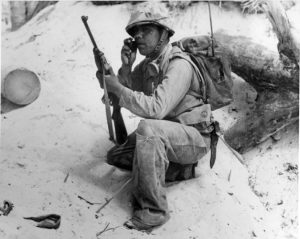By Sarah-Claire Jordan
As I’ve said before, military communication and its effectiveness is extremely important. Not only does it keep the military and its many branches running smoothly, but it also prevents certain catastrophes from happening as well as helping to establish a sense of culture among soldiers and military personnel. The NATO phonetic alphabet serves a very important purpose, but it wouldn’t work if you wanted to send messages back and forth while the enemy is out there tapping into your communication lines.
That is where code talkers come in, military personnel who understood and spoke very uncommon languages and used them to communicate crucial information to each other. The most important part is that the language be one that the enemy probably never heard of, and not similar at all to one they might know. Many code talkers were soldiers who also happened to grow up in a family that spoke one of these languages, but a few became fluent over time through studying.
When deciding which languages would be best suited for use as a military code language, Native American languages tended to win out. It makes sense, though, that they would be used. They have nothing in common with languages not found in the Americas, and more often than not do not have any written record that an enemy could get their hands on. The first Native American languages used were Cherokee, Choctaw, and Comanche. Cherokee was used during a particular battle of World War I, and Choctaw soldiers were also used in that same war.
Before World War II, Hitler sent anthropologists to the U.S. to try to learn some Native American languages in case the U.S. tried to use them on the European front. Because of this, the use of code talkers wasn’t so prevalent in World War II. However, some Comanche soldiers proved their worth during the Invasion of Normandy, greatly impacting the outcome. Not only did they speak in a language that Hitler’s forces could not decipher, the also used code words in Comanche, using terms such as, for example, “pregnant airplane” and “turtle” to refer to bomber planes and tanks.
The code talkers that most Americans know about are the ones who spoke Navajo. Navajo code talkers were used extensively in World War II. The Navajo language was perfect for use as a code language, since it wasn’t even mutually intelligible with other languages in its own language family. On top of that, Navajo grammar is extremely complex and it is not a written language. Eventually the Marines, who used Navajo code talkers, recognized that, instead of spelling out code terms phonetically which took too long, they could just use the Navajo word for whatever they wanted to say. Some of these terms are still used today.
Other languages have been used too over the course of modern human history as a way of keeping the enemy from cracking the code, such as Basque and Nubian, but the majority of code talkers used Native American languages, mostly because they are unique to our continent and the communities that were here first.
or an overview of our translation expertise, visit our telephone interpreting service page




